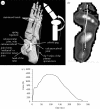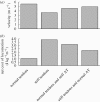Arboreality, terrestriality and bipedalism
- PMID: 20855304
- PMCID: PMC2981953
- DOI: 10.1098/rstb.2010.0035
Arboreality, terrestriality and bipedalism
Abstract
The full publication of Ardipithecus ramidus has particular importance for the origins of hominin bipedality, and strengthens the growing case for an arboreal origin. Palaeontological techniques however inevitably concentrate on details of fragmentary postcranial bones and can benefit from a whole-animal perspective. This can be provided by field studies of locomotor behaviour, which provide a real-world perspective of adaptive context, against which conclusions drawn from palaeontology and comparative osteology may be assessed and honed. Increasingly sophisticated dynamic modelling techniques, validated against experimental data for living animals, offer a different perspective where evolutionary and virtual ablation experiments, impossible for living mammals, may be run in silico, and these can analyse not only the interactions and behaviour of rigid segments but increasingly the effects of compliance, which are of crucial importance in guiding the evolution of an arboreally derived lineage.
Figures




Similar articles
-
Spinopelvic pathways to bipedality: why no hominids ever relied on a bent-hip-bent-knee gait.Philos Trans R Soc Lond B Biol Sci. 2010 Oct 27;365(1556):3289-99. doi: 10.1098/rstb.2010.0112. Philos Trans R Soc Lond B Biol Sci. 2010. PMID: 20855303 Free PMC article. Review.
-
Origin of human bipedalism as an adaptation for locomotion on flexible branches.Science. 2007 Jun 1;316(5829):1328-31. doi: 10.1126/science.1140799. Science. 2007. PMID: 17540902
-
Orrorin tugenensis femoral morphology and the evolution of hominin bipedalism.Science. 2008 Mar 21;319(5870):1662-5. doi: 10.1126/science.1154197. Science. 2008. PMID: 18356526
-
Forearm articular proportions and the antebrachial index in Homo sapiens, Australopithecus afarensis and the great apes.Homo. 2015 Dec;66(6):477-91. doi: 10.1016/j.jchb.2015.07.001. Epub 2015 Jul 17. Homo. 2015. PMID: 26256651
-
The evolutionary relationships of man and orang-utans.Nature. 1984 Apr 5-11;308(5959):501-5. doi: 10.1038/308501a0. Nature. 1984. PMID: 6424028 Review.
Cited by
-
Ticks, Hair Loss, and Non-Clinging Babies: A Novel Tick-Based Hypothesis for the Evolutionary Divergence of Humans and Chimpanzees.Life (Basel). 2021 May 12;11(5):435. doi: 10.3390/life11050435. Life (Basel). 2021. PMID: 34066043 Free PMC article.
-
Comparison of musculoskeletal networks of the primate forelimb.Sci Rep. 2017 Sep 5;7(1):10520. doi: 10.1038/s41598-017-09566-7. Sci Rep. 2017. PMID: 28874673 Free PMC article.
-
Daily activity in minimal footwear increases foot strength.Sci Rep. 2021 Sep 20;11(1):18648. doi: 10.1038/s41598-021-98070-0. Sci Rep. 2021. PMID: 34545114 Free PMC article.
-
Ape femoral-humeral rigidities and arboreal locomotion.Am J Biol Anthropol. 2022 Dec;179(4):624-639. doi: 10.1002/ajpa.24632. Epub 2022 Oct 31. Am J Biol Anthropol. 2022. PMID: 36790629 Free PMC article.
-
Inverse remodelling algorithm identifies habitual manual activities of primates based on metacarpal bone architecture.Biomech Model Mechanobiol. 2019 Apr;18(2):399-410. doi: 10.1007/s10237-018-1091-y. Epub 2018 Nov 9. Biomech Model Mechanobiol. 2019. PMID: 30413983 Free PMC article.
References
-
- Alexander R. McN.1991Characteristics and advantages of human bipedalism. In Biomechanics in evolution (eds Rayner J. M. V., Wooton R. J.), pp. 225–266 Cambridge, UK: Cambridge University Press
-
- Alexander R. McN.2003Principles of animal locomotion. Princeton, NJ: Princeton University Press
-
- Almécija A., Alba D. M., Moyà-Solà S.2009Pierolapithecus and the functional morphology of Miocene ape hand phalanges: paleobiological and evolutionary implications. J. Hum. Evol. 57, 284–297 (doi:10.1016/j.jhevol.2009.02.008) - DOI - PubMed
-
- Berillon G.2000Le Pied des Hominoïdes Miocènes et des Hominides Fossiles. Paris, France: Éditions du CRNS
Publication types
MeSH terms
Grants and funding
LinkOut - more resources
Full Text Sources

